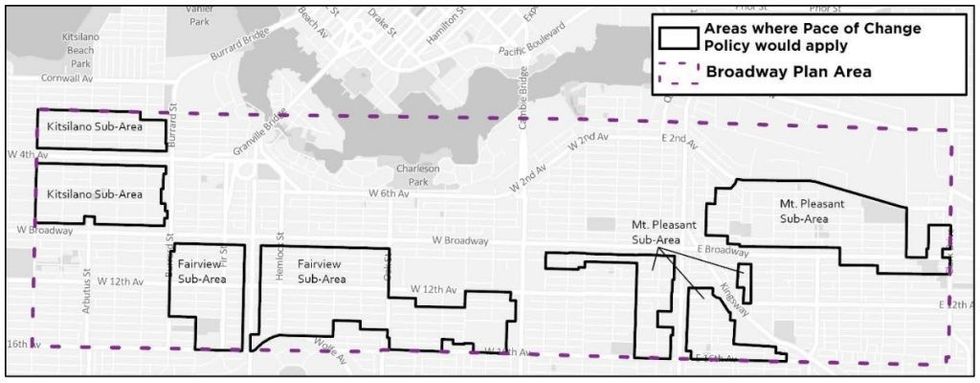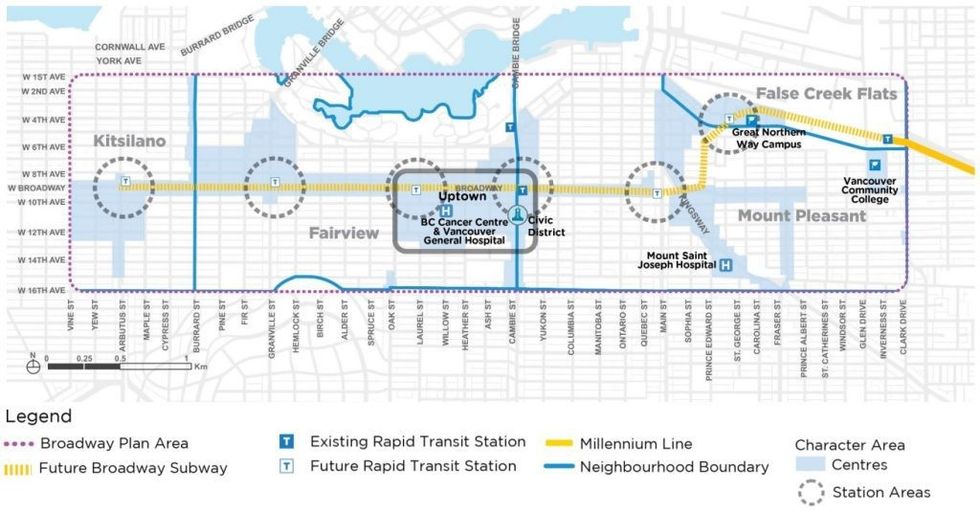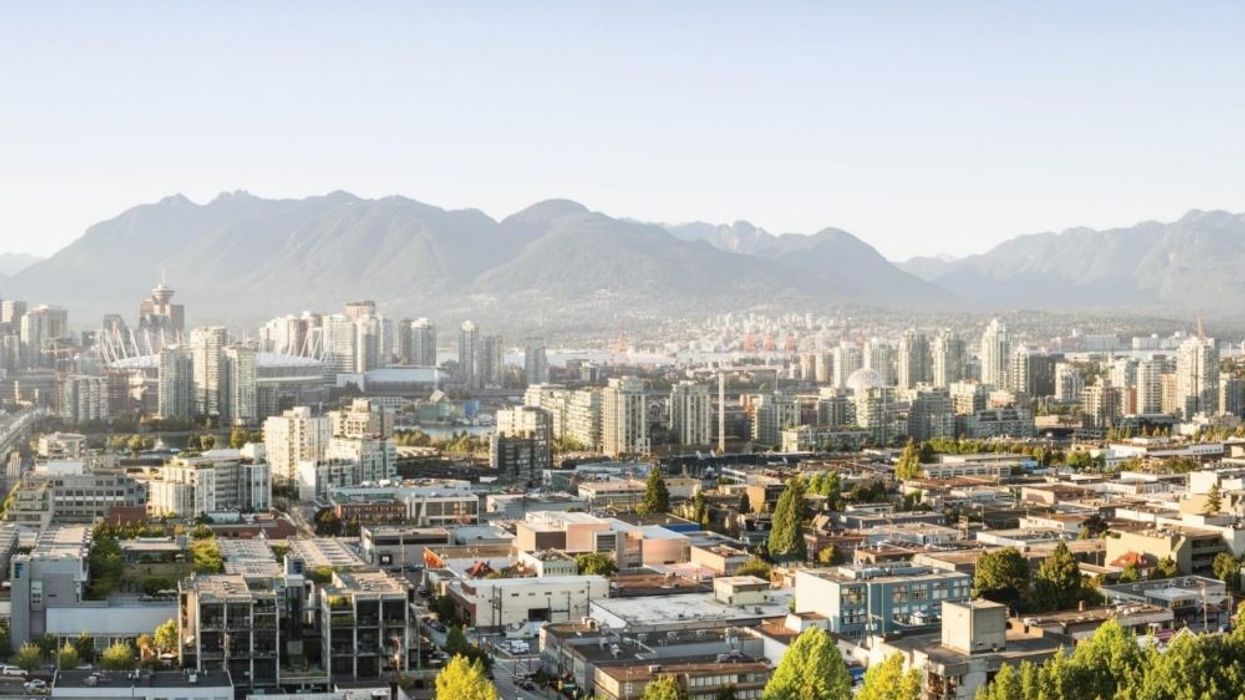The Broadway Plan remains one of the biggest -- if not the biggest -- undertaking that's underway in the City of Vancouver, and disagreement about implementation and development has heated up recently after it was revealed that the City is considering a "Pace of Change Policy" that would control the tempo of redevelopment in the Broadway Corridor.
The proposed Pace of Change Policy comes after Council directed staff last year to explore the possibility and outline potential options that would control the pace of change specifically within areas of the Broadway Plan designated for rental housing.
Part of the motivation for exploring the idea is the concern that allowing the redevelopment of everything everywhere all at once could potentially result in a scenario where too many renters and too much existing rental housing units will be impacted simultaneously, in a city where rental units are already hard to find and average rents are the highest in the nation.
The thought is that controlling the pace of redevelopment will lower the amount of tenants who are impacted at a given time, and as such, the City is now considering four pacing options: three with annual project limits of five, 15, and 30, respectively, and a fourth option with no limit at all.
Project limits in this case are defined as the number of rezoning applications -- received as of September 1, 2022 -- being processed that involve redevelopment of existing rental housing in RM-zoned areas, as identified in the Broadway Plan.
Depending on the option, the estimated amount of renter households that could be impacted by redevelopment ranges from 180 to 910, and even up to 2,000 -- per year -- if no hard limit is set. With no limit on the amount of projects per year, as much as 10% of the existing rental stock in Vancouver could be impacted, per year, as opposed to just 1%, 3%, or 5% with the low project options.

The Policy would apply only to projects within the Residential Apartment sub-areas of the Broadway Plan that are zoned as: RM-3, RM-3A, RM-4, RM-4N, and CD-1, and would not apply to sites zoned as RM or CD-1 that are outside the Residential Apartment sub-areas.
The Policy also does not apply to social housing projects, co-operative housing projects, projects that can commence without rezoning, projects that do not involve redevelopment of existing rental housing, and projects that involve redevelopment of existing rental housing where the number of new below-market units would be double the amount of existing rental units.

While the Pace of Change Policy would control the pace of redevelopment in the Broadway area, it also includes aspects that control the speed of individual development projects. According to a draft version of the Pace of Change Policy, the "year" is defined as September 1 to August 31. All relevant rezoning applications would be reviewed at once, beginning on September 1 of each year, with project developers notified on August 1 and asked if they would like their project to be included in the review.
The projects will then be prioritized "based on the ratio of new permanently-secured below-market rental housing units provided, compared to the number of existing rental units on site that are impacted by the development," according to the policy draft.
"Once a complete rezoning application submission has been identified by staff as part of the annual project quota, proponents are expected, in good faith, to make progress on the project without unreasonable delay," the draft reads. "If during the rezoning application process a project is dormant for longer than three months, staff may make an assessment to remove that application from the annual project quota and/or invite another project on the waitlist to proceed."
After the year's quota has been filled, the remaining applications will then be waitlisted to be included in the following year's review. If spots go unfilled, for whatever reason, they can also be carried over to the following year.
Taking It Slow vs. Going At Your Own Pace
While staff have presented four options, they are recommending Option 1, where the annual project limit cap would be set at just five, saying in a report that "a limited initial pace of change would allow new below-market rental stock to be built in the Centres and Station Areas where no limits on pace of change would apply, increasing capacity in the rental stock to better accommodate tenant relocation."
Those Centres are located in the immediate radiuses of the six future stations of the upcoming Broadway Subway Project, with the Centres mostly then extending out from the Stations for a several blocks.

City staff also say that the slow pace of change would "enable staff, industry, and renter households to work through implementation and assess the effectiveness of the new tenant protection measures." Those protection measures are provisions that give tenants in old buildings set to be redeveloped the option to return to a similar unit in the new building, at their old rent. While the new building is being constructed, those tenants would also be assisted with finding a new home, with developers topping up their rent, if needed.
Those protective measures were greatly inspired by those that the City of Burnaby introduced years ago, and many who are opposed to the five-projects-a-year pace say that the measures are a sufficient measure to protect tenants and that no further regulation of development is necessary.
City staff also note that their recommendation of five projects a year is only for the first three years, during which the City can assess the effectiveness of the Pace of Change Policy and then review, adjust, or appeal the policy after that period, if needed. The draft of the Policy also notes that it can be reviewed every three years after that.
READ: Reliance, QuadReal Propose Twin 29 and 28-Storey Rental Towers On Broadway
Both the staff report and other media reports have alluded to many in the development industry voicing strong displeasure with the five-project cap when the City broached the idea to them during private consultations.
Although the Bank of Canada has paused interest rate hikes, the financial environment still has its challenges. Putting a cap on the amount of projects per year means developers would have to get in line, one after the other, further extending development timelines that often already frustrate developers.
Having to wait in line would likely result in increased costs associated with holding land, and the more time it takes for a project to be delivered, the more it costs developers, and those costs could very likely then be passed down to users.
The City is expected to vote on the Broadway Pace of Change Policy in a Standing Committee on Policy and Strategic Priorities meeting on Wednesday, March 29.





















